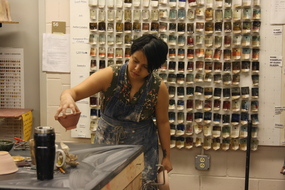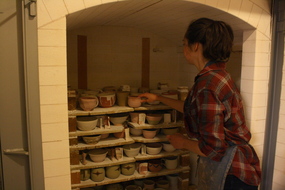It’s affectionately known as “throwing night.” Current and former students, professors, roommates, friends, and random volunteers gather in the Boliou Hall ceramics studio to create handmade bowls—or throw clay—on the potter’s wheel.
Normally viewed as a solitary form of artistic expression, bowl making becomes elevated by the party-like atmosphere. Music blares. Art professor Kelly Connole orders pizza. Everyone claims a role in the unique process and purpose—crafting the majority of soup vessels for Friday’s 10th annual Empty Bowls fundraiser on the Bald Spot.
“From the beginning, Kelly stresses the community aspect of this. Everyone has a hand in the bowls being made,” says Ellen Kwan ’15 (Pleasanton, California), a studio arts major. “Someone throws it. A different person trims it. Someone else glazes it. No single set of initials is put on a bowl. When people ask later, ‘Which is yours?’ … we all made these bowls. It’s really the community of a classroom.”
The bowl: Simple in its utility, complex in its construction. Perhaps an appreciation for the latter tenet can only be gained upon patiently manipulating the wheel, and watching as time after time, attempts to shape bowls collapse without warning.
Victoria Rachmaninoff ’16 (Winnetka, Illinois) used to stare helplessly as her hands rubbed raw due to poor technique. As she improved her bowl making skills, Rachmaninoff also began to gain a greater appreciation for the story each completed treasure told.
“Before I started throwing, I never thought about what I wanted to eat out of, what felt right in my hands. Now I’m very particular. I want a bowl that feels nice,” she says. “It’s been interesting to see my appreciation for that grow, to think about the artist’s vision for a bowl, why someone made it a certain way.”
Empty Bowls is an opportune time for reflection on a number of levels. A collaboration between Carleton’s ceramics department and the Center for Community and Civic Engagement (CCCE), the event features more than 600 bowls handcrafted by students, along with soup made by residents of Carleton interest houses.
For a suggested donation of $15, members of the public can pick their own bowl, fill it with soup, and leave with a keepsake. All proceeds go to Northfield Community Action Center’s food shelf.
“Empty Bowls is cool because you can see the tangible outcomes. We can often live in a bubble on this campus, and it’s easy to think that everything in Norfhfield is about Carleton,” says Rachmaninoff, a studio arts/sociology and anthropology major. “But I’ve read that Rice County has some of the highest poverty levels in Minnesota. You get a couple of miles out of the (campus) area and it’s very different than what you see at Carleton. I think Empty Bowls has helped make students aware of that.”
Then there’s Connole, who started Empty Bowls at Carleton with a lone student assistant. As CCCE invests in weeklong hunger awareness activities and general event logistics, Connole’s been able to step back as the ringleader and focus on what prompted her to bring the idea here in the first place.
“I believe in the goodness of Empty Bowls, but to me, it’s also really important that the project connect students back to the way most ceramic objects in the world have been made. I’m so receptive to something that pulls them outside the normal ways that they work,” Connole says.
Which is why you’ll also find Connole on the assembly line, throwing next to students. “It’s where I should be,” Connole says, and it shows them that everyone has a stake in the bowls that are being created. They become conversation points, special reminders of the myriad working styles and individual personalities invested in each one.
“I look at it as a way to have everyone get to know the bowls before glazing them. I want them to think about the information that someone else gave them. ‘Who made this part of the bowl. What did they offer you? How do you add the next layer?’” Connole says.
Beyond technique, Connole also has her students read articles about the “humble bowl,” or how in Japanese culture, if a raku tea bowl is cracked, an artisan will repair it with gold “so the imperfection becomes the most precious part.” Students have also learned about historic pairings of food movements and handmade pottery, or how some master chefs in New York make it a point to serve their food only on handmade objects.
“Bowls are all so different. From the foot, to how much curves out, Kelly teaches us how to approach making objects in such a thoughtful way. To think about all the small elements,” Kwan says. “I know for me, it’s still surprising to think about how we encounter so many objects, yet don’t necessarily know why we interact with them in a certain way. There’s a lot of thought in creating them, a lot of intentionality.”
SOUP’S ON!
When: 11:45 a.m. to 1:15 p.m., Friday
Where: Bald Spot, center of Carleton campus. The event will be moved to Severance Great Hall if it rains.
Cost: $15 suggested donation for a bowl of soup and side of bread. Patrons keep the handmade bowl.
Also: All week, CCCE is asking students to sign up and donate a meal through Café Fast, which will raise additional funds for the Community Action Center’s Food Shelf in Northfield. Students or staff wishing to make a pot of vegetarian soup for the event can contact Anna Persmark at persmara@carleton.edu.
More: To learn about the history of Empty Bowls as an international fundraiser, visit www.emptybowls.net.





